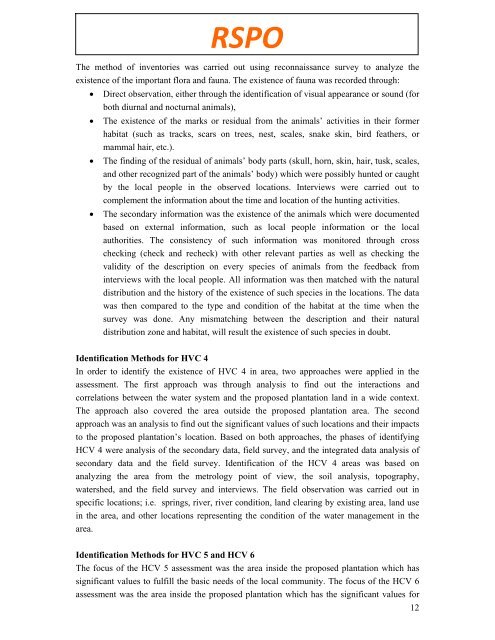3-rspo notification of proposed new planting - HCV Resource Network
3-rspo notification of proposed new planting - HCV Resource Network
3-rspo notification of proposed new planting - HCV Resource Network
Create successful ePaper yourself
Turn your PDF publications into a flip-book with our unique Google optimized e-Paper software.
RSPO<br />
The method <strong>of</strong> inventories was carried out using reconnaissance survey to analyze the<br />
existence <strong>of</strong> the important flora and fauna. The existence <strong>of</strong> fauna was recorded through:<br />
• Direct observation, either through the identification <strong>of</strong> visual appearance or sound (for<br />
both diurnal and nocturnal animals),<br />
• The existence <strong>of</strong> the marks or residual from the animals’ activities in their former<br />
habitat (such as tracks, scars on trees, nest, scales, snake skin, bird feathers, or<br />
mammal hair, etc.).<br />
• The finding <strong>of</strong> the residual <strong>of</strong> animals’ body parts (skull, horn, skin, hair, tusk, scales,<br />
and other recognized part <strong>of</strong> the animals’ body) which were possibly hunted or caught<br />
by the local people in the observed locations. Interviews were carried out to<br />
complement the information about the time and location <strong>of</strong> the hunting activities.<br />
• The secondary information was the existence <strong>of</strong> the animals which were documented<br />
based on external information, such as local people information or the local<br />
authorities. The consistency <strong>of</strong> such information was monitored through cross<br />
checking (check and recheck) with other relevant parties as well as checking the<br />
validity <strong>of</strong> the description on every species <strong>of</strong> animals from the feedback from<br />
interviews with the local people. All information was then matched with the natural<br />
distribution and the history <strong>of</strong> the existence <strong>of</strong> such species in the locations. The data<br />
was then compared to the type and condition <strong>of</strong> the habitat at the time when the<br />
survey was done. Any mismatching between the description and their natural<br />
distribution zone and habitat, will result the existence <strong>of</strong> such species in doubt.<br />
Identification Methods for HVC 4<br />
In order to identify the existence <strong>of</strong> HVC 4 in area, two approaches were applied in the<br />
assessment. The first approach was through analysis to find out the interactions and<br />
correlations between the water system and the <strong>proposed</strong> plantation land in a wide context.<br />
The approach also covered the area outside the <strong>proposed</strong> plantation area. The second<br />
approach was an analysis to find out the significant values <strong>of</strong> such locations and their impacts<br />
to the <strong>proposed</strong> plantation’s location. Based on both approaches, the phases <strong>of</strong> identifying<br />
<strong>HCV</strong> 4 were analysis <strong>of</strong> the secondary data, field survey, and the integrated data analysis <strong>of</strong><br />
secondary data and the field survey. Identification <strong>of</strong> the <strong>HCV</strong> 4 areas was based on<br />
analyzing the area from the metrology point <strong>of</strong> view, the soil analysis, topography,<br />
watershed, and the field survey and interviews. The field observation was carried out in<br />
specific locations; i.e. springs, river, river condition, land clearing by existing area, land use<br />
in the area, and other locations representing the condition <strong>of</strong> the water management in the<br />
area.<br />
Identification Methods for HVC 5 and <strong>HCV</strong> 6<br />
The focus <strong>of</strong> the <strong>HCV</strong> 5 assessment was the area inside the <strong>proposed</strong> plantation which has<br />
significant values to fulfill the basic needs <strong>of</strong> the local community. The focus <strong>of</strong> the <strong>HCV</strong> 6<br />
assessment was the area inside the <strong>proposed</strong> plantation which has the significant values for<br />
12

















